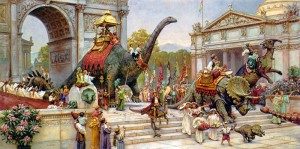
James Gurney (b. 1958)|Dinosaur Parade, 1992|Illustration for Dinotopia: A Land Apart From Time (Atlanta, GA: Turner Publishing, 1992)|Oil on illustration board
In his Dinotopia story series, author and illustrator James Gurney has created a lost island where dinosaurs survived whatever destroyed their species in our world and where people and animals work to live in a harmonic “peaceful interdependence.” A Land Apart From Time is the first of four books Gurney created to tell the tale of this magical, beautiful place. As Gurney tells it, his own work is based upon the discovered journals of a 19th century explorer, Arthur Denison. One of Gurney’s websites (www.dinotopia.com) includes his description of first finding a sketchbook by Denison and later finding one of Denison’s journals.
Gurney’s illustration of the Dinosaur Parade created for that first book, takes place in the capitol of Dinotopia, Sauropolois. This city was designed and built in the Roman style, but constructed to accommodate the island’s larger dinosaur citizens. For example, entries into buildings must be at least 50 feet high. As we can see in this illustration, step platforms are oversized to accommodate larger dinosaur feet. The parade itself wanders through the capitol’s streets, and so provides us with a wonderful view of the look of the city and the creatures and people who inhabit it. No wonder this image was also used for the book’s cover.
Gurney’s illustration clearly references views of ancient Rome painted by the English/Dutch artist, Sir Lawrence Alma-Tadema (1836-1912). In the 1860s the artist made his first trip to Italy and there encountered the ruins of ancient Roman cities to which he returned many times. Subsequently, Alma-Tadema became famous for his paintings recreating ancient Rome, the luminous flesh tones of his images of nubile young women, and for his skill in painting the look of marble. It was his realistic depiction of marble that led him to be called a ‘marbelous painter.’
No doubt using some of Alma-Tadema’s recreations of ancient Rome as his inspiration, James Gurney also convincingly portrays the glowing translucent quality of cut marble in the sunlight. Architectural details reflect Gurney’s dense knowledge of that ancient empire, but instead of reliefs of people and people activities decorating his buildings, Gurney paints reliefs of dinosaurs. You can see them in the spandrels flanking the triumphal arch through which the parade passes, and inside the arch a relief of mixed species echoes the parade passing through the arch. Also in the temple’s pediment decoration you can see a mixture of people-like gods and those in dinosaur form as well. In the foreground of the parade a group of young women in classic garb hold basket trays of flower petals or play a tambourine. They too are beholden to Alma Tadema’s young girls leading the May Day procession in his 1894 painting Spring.
Gurney comfortably borrows from other 19th century academic and orientalist painters as well. The most obvious example is the howdah* (the canopied seat for riding on the back of a large animal like a camel or an elephant) atop the Apatosaurus (was known as a Brontosaurus) in the parade. Or the decorative blanket and saddle baskets balanced on the back of the Triceratops walking next to the young girls and their flower baskets. Notice the bronze sculptural heads of a Triceratops decorating the over-large finial at the end of the foreground wall.
Gurney has well understood the visceral visual appeal of the late 19th century story-telling paintings by Alma-Tadema and other academic artists. By marrying his understanding and his considerable skill as an illustrator/story-teller, James Gurney created a new series of stories and the pictures to make them memorable.
* In ancient Rome, howdah (also houdah) topped elephants were used in battle and their image were applied to decorated coinage in the 1st c. BC. You have also seen a fantasy version of the howdah atop the massive battle elephants in the last battle of the Return of the King movie of the Lord of the Rings Trilogy.
April 22, 2010
By Joyce K. Schiller, Curator, Rockwell Center for American Visual Studies
Located at the Norman Rockwell Museum







